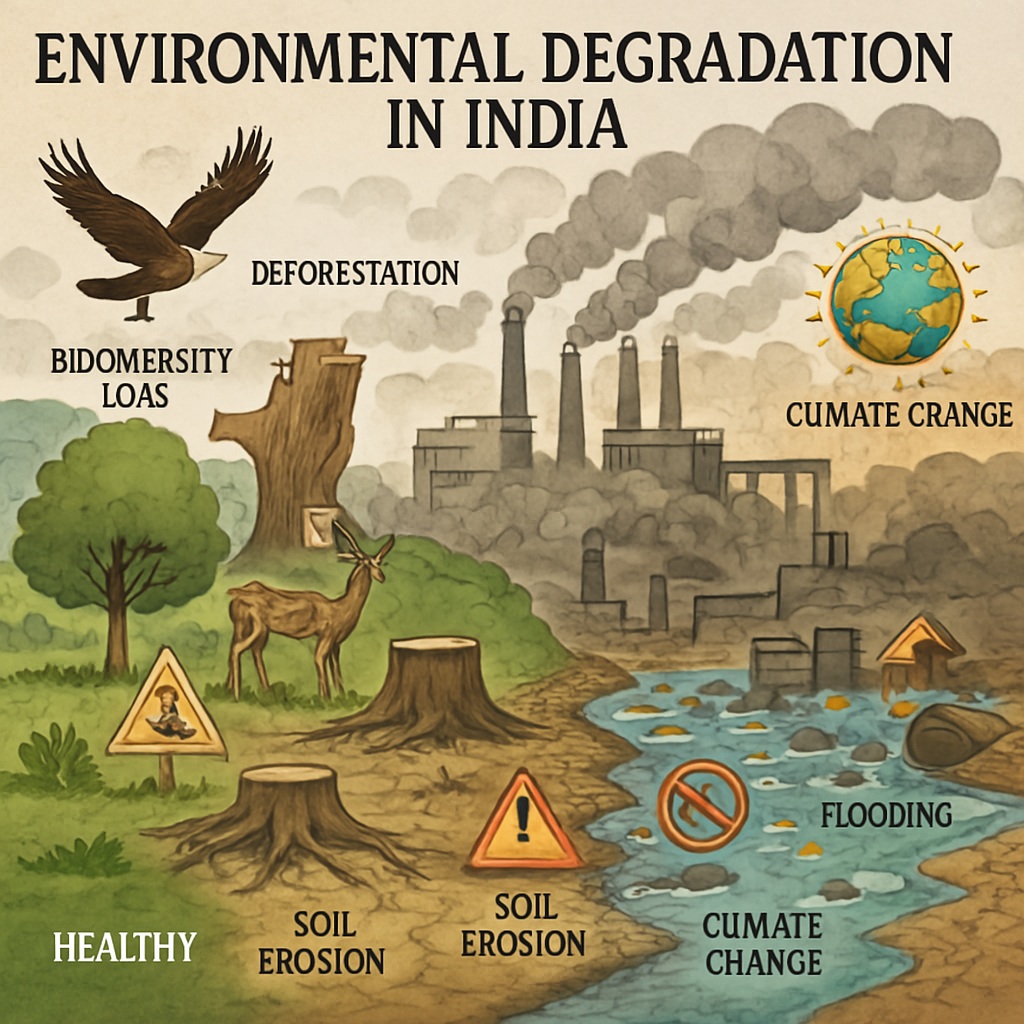Environmental degradation refers to the deterioration of the natural environment due to human activities and natural processes. It includes pollution, deforestation, loss of biodiversity, soil erosion, and climate change. In India, rapid industrialization, population growth, urbanization, and unsustainable development practices have significantly contributed to environmental degradation, threatening the country’s ecological balance and public health.

Table of Contents
What is Environmental Degradation?
Environmental degradation is the decline in the quality and quantity of natural resources, such as air, water, soil, forests, and biodiversity. It occurs when the environment is exploited beyond its capacity to recover, leading to long-term damage.
Major Causes of Environmental Degradation in India
- Deforestation
- Large-scale cutting of forests for agriculture, timber, mining, and urban expansion.
- Results in loss of biodiversity, climate imbalance, and soil erosion.
- Air Pollution
- Emissions from vehicles, factories, and thermal power plants.
- Major cities like Delhi, Mumbai, and Kolkata face hazardous air quality levels.
- Water Pollution
- Industrial effluents, sewage, and agricultural runoff pollute rivers like the Ganga and Yamuna.
- Unsafe drinking water affects both human health and aquatic life.
- Soil Degradation
- Overuse of chemical fertilizers and pesticides.
- Loss of fertility, desertification, and reduced agricultural productivity.
- Waste Generation
- India generates over 1.5 lakh tonnes of solid waste daily.
- Poor waste management systems lead to land, air, and water pollution.
- Climate Change
- Global warming causes rising temperatures, unpredictable rainfall, droughts, and floods.
- Affects agriculture, water resources, and coastal areas.
- Overpopulation and Urbanization
- High population density puts immense pressure on natural resources.
- Expanding cities consume forests, wetlands, and fertile land.
Consequences of Environmental Degradation
- Health Issues: Respiratory problems, water-borne diseases, and malnutrition.
- Loss of Biodiversity: Extinction of species, loss of habitats, and imbalance in ecosystems.
- Agricultural Decline: Reduced soil fertility and crop yields.
- Natural Disasters: Increased frequency of floods, droughts, and heatwaves.
- Economic Costs: Decrease in productivity, higher healthcare costs, and damage to infrastructure.
Government Initiatives to Tackle Environmental Degradation
- National Action Plan on Climate Change (NAPCC)
- Focuses on renewable energy, energy efficiency, water conservation, and ecosystem protection.
- Swachh Bharat Abhiyan
- Nationwide mission for cleanliness and improved sanitation.
- Namami Gange Programme
- Focused on cleaning and rejuvenating the Ganga River.
- Environment Protection Act (1986)
- Legal framework to control pollution and protect ecosystems.
- Compensatory Afforestation Programme
- Afforestation in place of deforested land to maintain forest cover.
- National Green Tribunal (NGT)
- A special court that deals with cases related to environmental protection.
Role of Citizens and Communities
- Reduce, Reuse, Recycle: Minimize waste generation and promote sustainable consumption.
- Plant Trees and Conserve Water: Small actions can lead to big environmental benefits.
- Use Public Transport and Clean Energy: Reduce carbon footprint.
- Raise Awareness: Educate others about environmental issues and solutions.
- Participate in Clean-Up Drives and Eco-Friendly Campaigns
Conclusion
Environmental degradation is a serious threat to India’s sustainable development. If not addressed, it can lead to irreversible damage to the environment, economy, and human well-being. Protecting the environment is not just the responsibility of the government but of every citizen. Through awareness, responsible behavior, and collaborative efforts, India can work towards a cleaner, greener, and healthier future.
Read: Geography notes